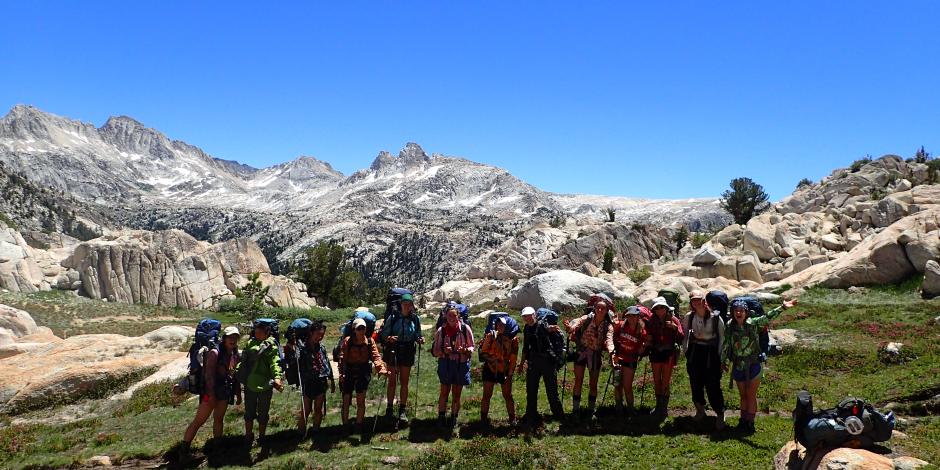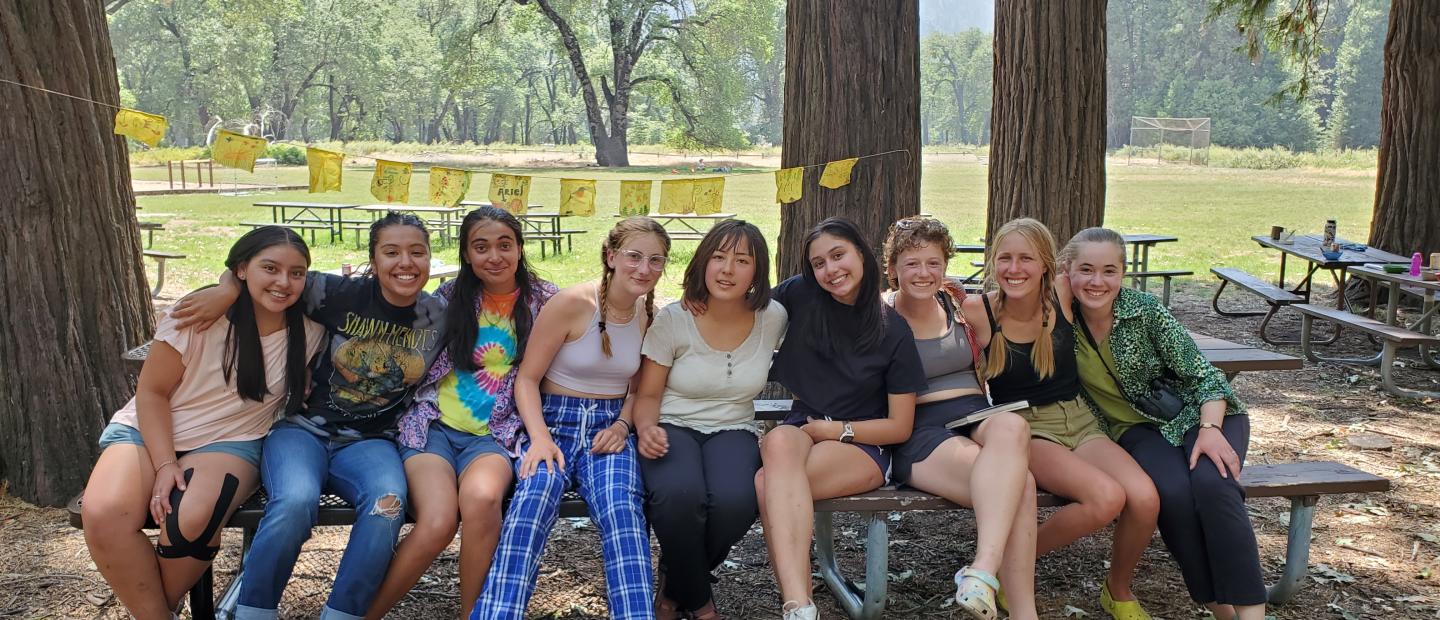Armstrong Scholars Part IV: The Hummingbird

At the end of the two-week journey into the Yosemite backcountry, the Armstrong Scholars program hosts a “closing campfire,” known to some simply as “Campfire.” The program, which began in 2000 after the murder of former NatureBridge educator Joie Armstrong, takes a group of young women ages 15-18 on the transformative backcountry trip of a lifetime. Campfire is where friends and family of those scholars gather to be regaled by stories from the immersive adventure. Dinner and drinks are served before the group shares their collective experience with all in attendance. Each young woman then shares how they were personally impacted by the program and what they’ll be taking with them from the journey.
The end of the trip is where educators will often realize just how much the participants have changed since it began. Parents and friends are often awestruck.
“For the leaders it’s like watching hair grow or paint dry,” says 2017 Armstrong leader Jenn Peach. “It’s sometimes hard to see changes as they’re happening, but you get back and parents go ‘wow, this isn’t the same daughter I dropped off!’”
The scholars and their experiences are the focal point of everyone in attendance. For the scholars, however, their focal point is usually someone else.
“I go as often as I can to thank these girls for being a gift to me,” says Leslie, mother of Joie Armstrong.
“I never get to the refreshments table because the girls always want to talk to me,” she laughs.

Leslie lives in St. Petersburg, Florida, but makes the annual trip out to Yosemite for Campfire, staying for a few weeks to see family in the area. It is there, at Campfire, that she is able to see the true fruits of the program inspired by her daughter.
“These girls go into the woods all scared and wimpy and they come back energized!” she says. “It’s this journey of self-discovery for them, finding out how strong they really are.”
Strength is something that Joie was known for, though it is easy to, in hindsight, attribute only the positive characteristics to the former NatureBridge educator, who has now become larger than life. People describe Joie as goofy, fun, wild, playful, energetic, bright, kind and courageous — all irrefutably true.
“I also tell the girls all the time that Joie was actually very scared about some things,” says NatureBride’s former Education Manager and Armstrong Scholars program manager in Yosemite Kim Laizer. “She overcame her fears, that’s what was important.”
“When Joie went on her first trip like that, she was terrified, talking about bears eating her and all that stuff,” says her mother. “She said she was scared to go, but she was going.”
Sharing stories of Joie being scared or anxious helps the scholars see beyond the deservedly mythic status of this incredible young woman; underscoring her humanity helps them see themselves in her.
“I’d tattle on Joie when I’d go to the campfires,” Leslie laughs. “I always share how when Joie was a little kid in 6th grade she’d sneak out the window to play with her friends or see her boyfriend.”
“I wanted to assure the girls that she actually was a regular kid. That’s something that they need to know so they can be inspired.”
It seems to have worked. Hundreds of young women have been inspired by Joie in what is, upon examination, a stirring reclamation of power; Joie was killed inside Yosemite National Park when she was an educator and leader, and now a dozen young women courageously voyage into the heart of Yosemite to find community and empowerment. The transformation Leslie saw in her daughter after exploring nature and overcoming her fears is now a staple, shared experience for the scholars.
The magic — I call it the magic — it really comes from the girls and it comes from Joie. We as leaders and managers are there to create a space that empowers young women to find community and connection. Joie and the girls do the rest.Kim Laizer
I would be remiss if I did not mention one particular shared experience that came up in every one of the interviews in this four-part series on the Armstrong Scholars: the hummingbird.
“Hummingbirds have long been associated with Joie, and they will come to past participants at the most magical moments,” says Kim with a smile. “They often follow the Armstrong Scholars.”
Hummingbirds are a unique paradox: they are incredibly beautiful and even with their boundless energy, seem delicate and ornate; yet they are tough, fierce and fearless, working their bodies so hard that they go into torpor, a type of miniature hibernation where their bodies nearly shut down in order to rest.
“If I see a hummingbird, that always prompts me to ask myself if everything is going well. Do I like where I am?” says Jenn Peach.
“A highlight [of the trip] for me was when we came over Red Peak Pass coming up out of Ottoway Lakes, we got buzzed and visited by a hummingbird...that was pretty magical,” says 2000 Armstrong leader Heather Sullivan.
“Every time I see a hummingbird now, I think of Joie,” says 2004 Armstrong Scholar and 2015 Armstrong leader Jacqueline Ruggieri.
“Pete Devine, the director who hired both Joie and me, was receiving an award at an AEOE [Association for Environmental and Outdoor Education] conference, and he was talking about Joie because of a scholarship program called Joie’s Daisies set up in her honor,” says Kim.
“Out of nowhere comes this hummingbird, and it just hovers right in front of me, and it stayed right there for several moments before flying away. Pete and I just looked at each other because we had this special moment that no one else realized.”
Even when the backcountry hike ends, the hummingbird remains a reminder of who Joie was for the participants. Hummingbirds seem to find former scholars and leaders all over the country at serendipitous times, living on past the glow of their two-week program experience. I even discovered a dozen of them flitting around a towering sycamore outside our home the day I interviewed Leslie Armstrong, the first I’d ever seen here.
“Joie loved hummingbirds!” says Leslie. “They were just her favorites...and you know, Joie was a lot like a hummingbird. She was bright and full of energy, racing around, soaking up as much life as she could.”
“It’s nice to hear everyone is seeing them. I still keep a bunch of hummingbird pictures in the house.”
Joie loved hummingbirds! They were just her favorites...and you know, Joie was a lot like a hummingbird. She was bright and full of energy, racing around, soaking up as much life as she could.Leslie
As the Armstrong Scholars program looks ahead to the next 50 years, one thing is for certain: the spirit of Joie is being actively kept alive. It is woven into the curriculum and through 20+ years of backcountry experiences. The scholars and the leaders and Leslie evoke Joie in ways big and small, inside and outside of the two-week journey.
“The magic — I call it the magic — it really comes from the girls and it comes from Joie,” says Kim. “We as leaders and managers are there to create a space that empowers young women to find community and connection. Joie and the girls do the rest.”
The program has grown in recent years, and is open to all women, trans-inclusive, from all ethnicities, races, sexual orientations, cultures, religions and socioeconomic statuses, and NatureBridge is actively focused on outreach and engagement to be more inclusive. What started as a 10-day trip with Heather Sullivan and Nicole DeJonge in 2000 is now a 14-day experience with volunteers clamoring to join resupply, an ever-growing Campfire and an expanding legacy built on Joie’s spirit.
“It doesn’t take away the pain of losing Joie, but it’s the best way to make something good come out of something horrible. To know it could be around for the next 50 years...it’s a gift to me,” says Leslie. “The program is truly awesome, and so was Joie.”
“So is Joie, actually. So is Joie.”

